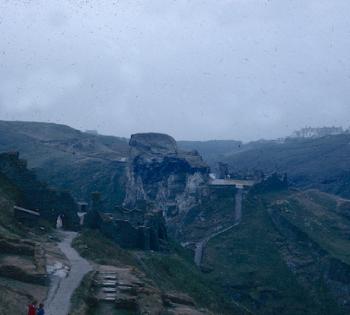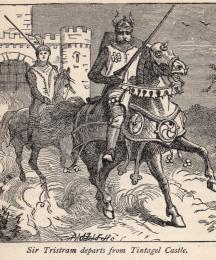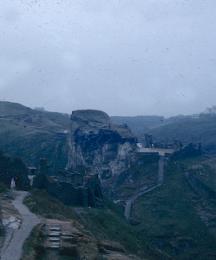According to Geoffrey of Monmouth and the chronicle tradition he inspires, Malory, and numerous other authors, Tintagel is the invincible castle where Gorlois, Duke of Cornwall, secures his wife Igraine from the advances of Uther Pendragon. It is there that she conceives Arthur when Uther, changed into Gorlois’s form by the magic of Merlin, enters the castle and impregnates her. In a number of Tristan romances, Tintagel is Mark’s castle. In the twelfth-century
La Folie Tristan (Oxford) Tintagel is called the Enchanted Castle because it vanishes twice a year, once in summer and once in winter. In Tennyson’s idyll “The Coming of Arthur” (1869), Bleyse is said to be the source of the alternate account of the coming of Arthur, that is, Arthur’s coming onto the shore below Tintagel on the ninth wave.Tintagel is also the subject of an orchestral tone poem called
Tintagel (1917-1919) by Arnold Bax (1883-1953), which reflects both the literal turbulence of the coast of Cornwall and the emotional turbulence of the Tristan legend.
The castle whose ruins are still found at Tintagel was built in the twelfth century; but there is evidence that the site was occupied, perhaps by a nobleman, as early as the fifth century.
BibliographyAshe, Geoffrey. With Photographs by Simon McBride. The Landscape of King Arthur. New York: Henry Holt and Co., 1988. (Pp. 66-75 discuss Tintagel.)
Ditmas, E. M. R. “The Invention of Tintagel.” Bulletin Bibliographique de la Société Internationale Arthurienne 23 (1971): 131-36.
Earl, Benjamin. "Literary Tourism: Constructions of Value, Celebrity and Distinction." International Journal of Cultural Studies 11.4 (Dec. 2008 Dec): 401-417.
Morley, Patricia. “Patrick Whyite’sw A Finge of Leaves: Jourey to Tintagel." World Literature Written in English 21.2 (Summer 1982): 303-315.
Noble, James. "Tintagel: The Best of English Twinkie." In King Arthur in Popular Culture. Ed. Elizabeth S. Sklar and Donald Hoffman. Jefferson, NC: McFarland, 2002. Pp. 36-43.
Radford, C. A. Ralegh. "Romance and Reality in Cornwall." In Geoffrey Ashe, Leslie Alcock, C. A. Ralegh Radford, and Philip Rahtz. The Quest for Arthur's Britain. London: Pall Mall Press, 1968. Pp. 59-77. (Pp. 59-70 deal specifically with Tintagel.)
Simpson, Roger. "Landon's 'A Legend of Tintagel Castle': Another Analogue of Tennyson's 'Thye Lady of Shalott.'" The Tennyson Research Bulletin 4:4 (Nov. 1985): 179-185.
According to Geoffrey of Monmouth and the chronicle tradition he inspires, Malory, and numerous other authors, Tintagel is the invincible castle where Gorlois, Duke of Cornwall, secures his wife Igraine from the advances of Uther Pendragon. It is there that she conceives Arthur when Uther, changed into Gorlois’s form by the magic of Merlin, enters the castle and impregnates her. In a number of Tristan romances, Tintagel is Mark’s castle. In the twelfth-century
La Folie Tristan (Oxford) Tintagel is called the Enchanted Castle because it vanishes twice a year, once in summer and once in winter. In Tennyson’s idyll “The Coming of Arthur” (1869), Bleyse is said to be the source of the alternate account of the coming of Arthur, that is, Arthur’s coming onto the shore below Tintagel on the ninth wave.Tintagel is also the subject of an orchestral tone poem called
Tintagel (1917-1919) by Arnold Bax (1883-1953), which reflects both the literal turbulence of the coast of Cornwall and the emotional turbulence of the Tristan legend.
The castle whose ruins are still found at Tintagel was built in the twelfth century; but there is evidence that the site was occupied, perhaps by a nobleman, as early as the fifth century.
BibliographyAshe, Geoffrey. With Photographs by Simon McBride. The Landscape of King Arthur. New York: Henry Holt and Co., 1988. (Pp. 66-75 discuss Tintagel.)
Ditmas, E. M. R. “The Invention of Tintagel.” Bulletin Bibliographique de la Société Internationale Arthurienne 23 (1971): 131-36.
Earl, Benjamin. "Literary Tourism: Constructions of Value, Celebrity and Distinction." International Journal of Cultural Studies 11.4 (Dec. 2008 Dec): 401-417.
Morley, Patricia. “Patrick Whyite’sw A Finge of Leaves: Jourey to Tintagel." World Literature Written in English 21.2 (Summer 1982): 303-315.
Noble, James. "Tintagel: The Best of English Twinkie." In King Arthur in Popular Culture. Ed. Elizabeth S. Sklar and Donald Hoffman. Jefferson, NC: McFarland, 2002. Pp. 36-43.
Radford, C. A. Ralegh. "Romance and Reality in Cornwall." In Geoffrey Ashe, Leslie Alcock, C. A. Ralegh Radford, and Philip Rahtz. The Quest for Arthur's Britain. London: Pall Mall Press, 1968. Pp. 59-77. (Pp. 59-70 deal specifically with Tintagel.)
Simpson, Roger. "Landon's 'A Legend of Tintagel Castle': Another Analogue of Tennyson's 'Thye Lady of Shalott.'" The Tennyson Research Bulletin 4:4 (Nov. 1985): 179-185.
Read Less







